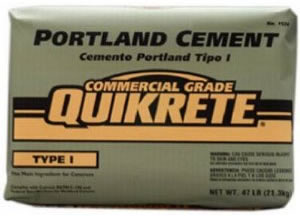Portland cement is the key ingredient in making concrete. There are many types of portland cement, some designed for specific applications, some for economy. It is important that you choose the portland cement that will work best in your project.

Figure 1 - Bag of Type I portland cement
In this article we will not discuss some of the specialty portland cement products that have been formulated for very specialized applications. It would be highly unusual for a homeowner to have a need for any of the specialty portland cement products.
Types of portland cement
Type I portland cement
The most common type of Portland cement is Type I.
Type I portland cement is comparatively inexpensive, so it is often used on big projects, but it tends to generate a lot of heat during the early stages of curing and then shrink and crack more than other types. Thus it’s useful for such applications as sidewalks, driveways and retaining walls but not for countertops or other architectural pieces where appearance and finish are important.
If you order ready mix concrete, you will most likely get a concrete with Type I portland cement unless you specify a different Type, so be sure to ask.
Note: Some ready mix concrete facilities will only supply Type I Portland cement.
Type II portland cement
Type II portland cement is a better product to use in concrete that is made for casting countertops and other architectural pieces where the appearance and finish is primary.
Type II portland cement does not shrink as much as Type I which helps to avoid cracking.
Concrete made with Type II portland cement gains strength more slowly than concrete made with Type III cement, however, and it ought to be kept undisturbed in the mold or form for at least one week after being poured. This can be very inconvenient if you are pouring on-site or in a confined shop and have to work around the form or mold.
Note: It is possible to purchase portland cement that meets both the Type I and Type II specifications. Products will be identified as Type I and Type II on the packaging.
Type III portland cement
Type III portland cement, is also known as “high-early” cement. It sets up at about the same rate as Type II Portland cement, but it gains strength much more quickly. After 3 days, for instance, concrete made with Type III cement is as strong as concrete made with Type II cement at 7 days; at 1 week, it is as strong as Type II portland cement at 28 days. At 28 days, however, concrete made with Type II or Type III portland cement are about equal in strength. Type III portland cement just achieves that strength more quickly.
Type III portland cement is a good choice if you are pouring on-site or in a busy workshop, because the pieces made with it can be broken out of the mold or form and moved out of the way 3 or 4 days after being poured. Type III portland cement is also a good choice if you are working in very cold or very hot, dry conditions, since you do not have to control the curing environment for more than 4 days, after which time the concrete will be more or less impervious to temperature extremes and low humidity. Type II portland cement needs to be protected from temperature and humidity extremes for at least 7 days.
White portland cement
White portland cement is blended without iron, so it is, as its name states, white. Besides being white, it has the same basic characteristics as Type II portland cement. White portland cement is typically used with pigments when bright or light colors are desired.
Note: There are different quality levels of portland cement even within a type. If you are going to create countertops or other types of architectural pieces, it is important that you purchase a quality product.
